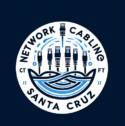What Cable Is Used for Communication? Understanding the Different Types and Their Uses
When it comes to building a reliable communication system, choosing the right cable is one of the most important decisions you’ll make. Whether it’s for internet, telephones, data networks, or security systems, the type of cable you use directly affects speed, clarity, and reliability.
In this guide, we’ll break down the most common communication cables, how they work, and which ones are best suited for your specific application — whether it’s in your home, office, or industrial facility. Our network cabling specialists in Santa Cruz deliver reliable communication wiring solutions for businesses and residential setups.
What Are Communication Cables?
Communication cables are designed to transmit signals, data, and power between devices. They’re used in everything from telephones and computers to security cameras and smart home systems.
In general, these cables carry electrical or optical signals that enable voice, video, and data communication across networks. Depending on the application, they can be made of copper wires or fiber optic strands.
The Main Types of Communication Cables
Let’s explore the most common types of communication cables used today and what makes each one unique.
1. Twisted Pair Cable
This is one of the most widely used communication cables, especially in networking and telephone systems. It consists of pairs of insulated copper wires twisted together to reduce electromagnetic interference.
Subtypes include:
- Unshielded Twisted Pair (UTP): Common in LAN networks and home wiring.
- Shielded Twisted Pair (STP): Includes shielding for extra protection in areas with high electrical noise.
Typical categories: CAT5e, CAT6, CAT6a, and CAT7 — each offering higher speed and bandwidth than the last.
Best for: Internet connections, VoIP systems, CCTV, and office networks.
2. Coaxial Cable
Coaxial cables have a single copper conductor surrounded by insulation, shielding, and an outer jacket. They’re durable and designed to carry high-frequency signals over longer distances with minimal interference.
Common uses:
- Cable television (CATV)
- Internet and broadband connections
- Video surveillance systems
Best for: TV signals, broadband internet, and long cable runs where durability is key.
3. Fiber Optic Cable
Fiber optic cables use thin strands of glass or plastic to transmit data as light signals. They deliver ultra-high speed and long-distance communication without interference from electrical noise.
Two main types:
- Single-mode fiber: Ideal for long-distance data transmission (up to several kilometers).
- Multimode fiber: Best for shorter distances, like within a building or campus.
Best for: Data centers, large enterprises, hospitals, universities, and smart cities that need fast and reliable connections.
4. Ethernet Cable (LAN Cable)
An Ethernet cable is a type of twisted pair cable used specifically for connecting devices in a local area network (LAN). Common versions include CAT5e, CAT6, and CAT6a, which support speeds from 1 Gbps up to 10 Gbps.
Best for: Home and business internet connections, computers, routers, and network switches.
5. Telephone Cable
Although not as common today due to digital communication, telephone cables (like Cat3 or older RJ11 connectors) are still used in some residential and small-business systems.
Best for: Analog phone lines and basic voice communication systems.
Fiber Optic vs. Copper Cables: Which Is Better?
The right choice depends on your needs and budget:
| Feature | Fiber Optic | Copper (Twisted Pair / Coaxial) |
|---|---|---|
| Speed | Up to 100 Gbps or more | Up to 10 Gbps |
| Distance | Longer (miles) | Shorter (hundreds of feet) |
| Interference | Immune to electrical noise | Prone to interference |
| Cost | Higher upfront | Lower upfront |
| Installation | Requires specialized tools | Easier to install |
If you need high-speed internet for a data-intensive business, fiber optic is the top choice. For smaller setups or budget-friendly installations, CAT6 or coaxial cables are excellent options. While communication cables transmit voice and signals, you can also learn what type of cable is used for internet to understand the difference between data and network cabling.
Choosing the Right Communication Cable for Your Needs
Here’s how to decide which type of cable is best for your project:
- Home network or small office: Use CAT6 Ethernet cables for strong and consistent connections.
- Commercial or enterprise setups: Use a mix of CAT6a and fiber optic cables for scalability and performance.
- Long-distance communication: Go with single-mode fiber optic for minimal signal loss.
- Video and broadband: Coaxial cable remains a reliable option.
When in doubt, consulting a structured cabling professional ensures your system meets performance goals and California building standards.
Why Professional Installation Matters
Improperly installed communication cables can lead to slow speeds, poor connections, and costly downtime. Certified installers make sure your cabling meets ANSI/TIA standards, local codes, and future-proof design requirements.
A professional will:
- Plan cable routes for optimal performance
- Terminate and test connections
- Label and document all cables
- Ensure compliance with state and safety codes
This approach guarantees a cleaner, faster, and more reliable communication network.
Final Thoughts
Communication cables are the unseen heroes of every connected environment — from your home Wi-Fi to massive data centers. The key is choosing the right type and having it installed correctly.
Whether you need CAT6 Ethernet, fiber optic, or coaxial cabling, the goal remains the same: seamless communication that supports your growing network demands. Older systems often relied on CAT4 wiring — discover what Cat 4 cable is used for and how it compares to modern options.
If you’re planning a new installation or upgrade, reach out to a certified network cabling expert in California to design a system that delivers speed, reliability, and long-term value.
